The MacBook Pro Review (13 & 15-inch): 2011 Brings Sandy Bridge
by Anand Lal Shimpi, Brian Klug & Vivek Gowri on March 10, 2011 4:17 PM EST- Posted in
- Laptops
- Mac
- Apple
- Intel
- MacBook Pro
- Sandy Bridge
Improved WiFi Performance
One of the more notable changes in the 2011 MacBook Pro lineup is a completely different WiFi chipset and subsequent RF design. The previous 2010 MacBook Pro included 802.11a/b/g/n support using a BCM4322 which included full 2x2 MIMO support, meaning two spatial streams were supported. Bluetooth 3.0 was provided by a BCM2070, and the whole solution was simply a BCM954224HMB reference design.

2011 MacBook Pro WiFi+BT Module—Courtesy iFixit
Back when the new Airport Extreme (Simultaneous Dual-Band II) launched, it included one little-hyped feature. One of the most notable improvements over the previous design was inclusion of a full 3x3 radio—again 3 spatial stream support. At the time, there were no Apple products that could actually use 3 spatial streams, and as a result many assumed the feature was completely locked down.
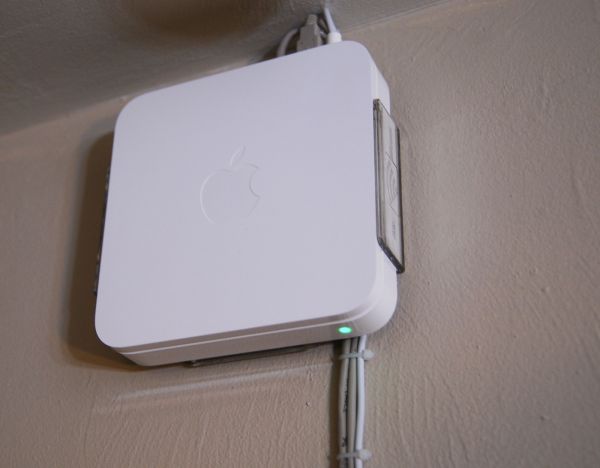
My wall-mounted Airport Extreme (Simultaneous Dual-Band II)
The Airport Extreme has had 3 spatial stream support for a long time to little fanfare. The Airport Extreme still only allows 20 MHz channels on 2.4 GHz spectrum. Other WiFi AP vendors ship firmware which will automaticaly selects 40 MHz channels on 2.4 GHz spectrum per WiFi Alliance rules, but Apple uniformly uses 20 MHz channels on 2.4 GHz. It's a design choice Apple made a while ago which still exists to this day – for two reasons. The first is that it prevents you from being, well, less than courteous and eating up to over 80% of spectrum on the already crowded 2.4 GHz ISM band with one AP. Apple's rationale for disabling 40 MHz channel support on the 2.4 GHz spectrum (for both clients and APs) is that Bluetooth needs lots of bandwidth to hop around on, and already a wide variety of Apple desktop and notebook products come by default with Bluetooth peripherals. Maintaining a good A2DP stereo stream for example requires considerable 2.4 GHz bandwidth. Instead, if you really want 40 MHz channels Apple recommends using 5 GHz, which Apple clients and Apple APs both allow to work with 40 MHz channels.
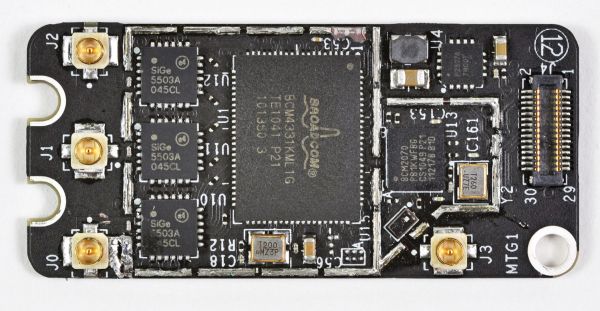
2011 MacBook Pro WiFi+BT Module—Courtesy iFixit
The 2011 MacBook Pro refresh is the first line of Apple products to bring 3x3 radios that can finally enable faster transfer rates and better performance at the edge of WiFi range. 3x3 MIMO support is starting to become relatively common in the PC notebook space, but this is the first for Apple. Inside the 2011 MacBook Pro is a BCM4331 and three clearly U.FL antenna connectors (on the left) for WiFi, as opposed to two in the previous design.
The fourth on the right is for Bluetooth, which remains 3.0 and provided by the same BCM2070 as previous models. Interestingly enough, though the Bluetooth controller is the same, the 2011 MacBook Pro includes newer firmware (37 vs 20), and software (2.4.3f1 vs 2.3.8f7). Hopefully at some point the older design will see a firmware update and bring whatever changes and improvements were made. Though the software versions are different, we couldn't detect any notable differences between the two in practice.

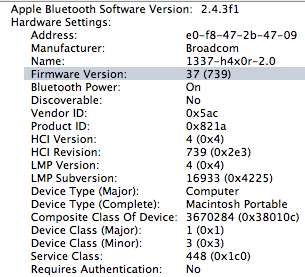
Left: 2010 MBP Bluetooth Hardware, Right: 2011 MBP Bluetooth
However, there's a dramatic improvement in both WiFi range and performance between the 2010 and 2011 refresh. With 400 ns guard intervals 40 MHz channels, 64-QAM modulation, each spatial stream adds n*150 Mbps. With 20 MHz channels, it's 72.2*n Mbps. For example, 1 spatial stream has a data rate of 150 Mbps, 2 has 300 Mbps, 3 has 450 Mbps, and so forth all the way up to 4 spatial streams and 600 Mbps as defined in the 802.11n specification. The reality of the matter is that what physical layer rate you'll see depends on the modulation and coding scheme and how many streams are going. You can look those up at any time by holding option and clicking the WiFi indicator, and looking them up in a table.
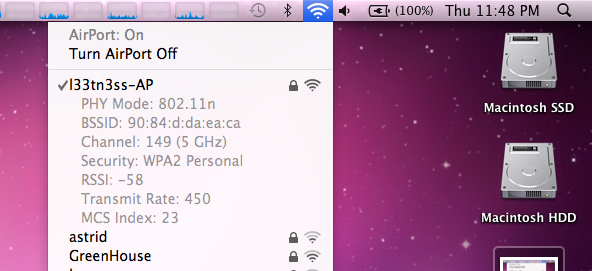
We tested a 15" 2011 MacBook Pro alongside a 15" 2010 MacBook pro connected to an Airport Extreme (Simultaneous Dual-Band II) running latest firmware. I originally suspected that 3 spatial stream support wasn't enabled, and that Apple would push a firmware update out right after their first 3 spatial stream products started shipping. Interestingly enough, it's always been there, enabled, this is just the first client I've gotten my hands on that does it. I'm not a huge fan of the Airport Extreme (I use a WRT54G-TM with Tomato and a WRT-600N with DD-WRT), but it's the only thing on hand with 3x3 MIMO. I tested in four different locations in my house—in my office, living room, kitchen, and outdoor patio. The base station is in my office mounted on the wall close to the ceiling, and those locations are subjectively ordered from best to worst.
To test, I initiated a large transfer over SMB (from a Windows Server 2008 R2 install with a 5 TB RAID5 array connected over gigabit ethernet) on each client, continually pinged AT, and at each location checked the reported transmit rate and RSSI. What we're reporting here is again the physical layer link. I'll show in a second that real-world transfers also improved, this just gives some perspective for what raw link rates are being negotiated at each location.
| WiFi Transfer Rate Differences—802.11n | ||||||||
| 2011 MacBook Pro | 2010 MacBook Pro | |||||||
| RSSI | Transfer Rate (Mbps) | RSSI | Transfer Rate (Mbps) | |||||
| Location 1—Office | -44 | 450 | -42 | 300 | ||||
| Location 2—Living Room | -61 | 130 | -64 | 117 | ||||
| Location 3—Kitchen | -69 | 117 | -68 | 78 | ||||
| Location 4—Outdoor Patio | -85 | 20 | -84 | 13 | ||||
In most cases, RSSI is within the margin of error. RSSI is generally not something you can compare, but since both wireless chipsets are Broadcom and the numbers are so close, it seems they're reported the same way and probably just dBm. Just know that generally it doesn't work that way unless you're lucky. What's important, however is that the negotiated link speed is noticeably better in essentially all locations on the new 2011 MBP. Even when the extra antenna isn't being used for a spatial stream of its own, it's actively improving link quality and helping the new MBP negotiate higher physical layer speeds.
So how much of a difference does 450 Mbps 3x3 make over 300 Mbps 2x2? With both in the exact same spot in my office, I saw throughput of 98.1 Mbps on the 2010 MBP compared to 113 Mbps on the 2011 MBP. The modest 15% improvement over the previous generation's wireless chipset isn't dramatic, instead the dramatically improved range is.
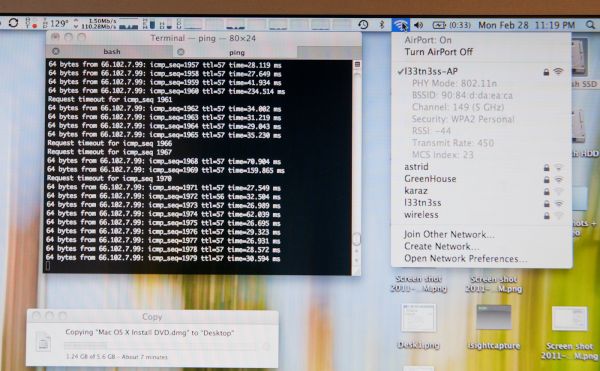 110.28 Megabits/s over WiFi. I later saw sustained 113 Megabits/s.
110.28 Megabits/s over WiFi. I later saw sustained 113 Megabits/s.
Subjectively, I found many more APs visible with the new MBP. I was able to cling onto my AP all the way out to the curb (just like smartphones) when connected on 2.4 GHz, something the old generation just couldn't do.
The only complaint I have about the new wireless chipset is that it seems to hunt around for what rate it wants negotiated. I saw a number of different MCS (modulation coding scheme) values with the 2011 MBP in the exact same place. Link rates from just below 300 Mbps all the way up to the expected 450. It seems to settle out at the expected 450 Mbps in the same room as the AP, it just takes a while, whereas other 2x2 stacks I've seen always lock onto 300 Mbps and stay there in the same room and position.










198 Comments
View All Comments
Brian Klug - Friday, March 11, 2011 - link
So I roll with my optical drive replaced with a Vertex 2 SSD inside an OptiBay daily. It's an awesome combination if you can do it.One problem I noticed however is that Apple's EFI won't boot optical drives other than their own $79 external drive. That means if you want to use boot camp, you have to install Windows with the optical drive (internal SATA) connected, then do the swap to OptiBay SSD + HDD.
-Brian
AmdInside - Thursday, March 10, 2011 - link
I'm just not that interested in this years lineup. The better CPU performance is nice but given how much more features Windows notebooks provide today, I feel I can rely on Windows notebooks as a desktop replacement much more than I can a Macbook Pro. I will still use my MBP 13 2010 for home use but for business, I rely on my Windows laptop.Braddik - Thursday, March 10, 2011 - link
Amazing article! I love how thorough and detailed you are. Mad props! I work in a medium-large size organization and the Dell vs. Apple debate is hot right now. Our Mac user base is growing, but the majority of the organization is Dell. I would love an article that compares the performance/value/support of MacBook Pros vs. Dell Latitudes in the Enterprise environment. Which is better? Can/should organizations feasible make the move to a full Mac environment? I would love your input! Thanks!Anand Lal Shimpi - Friday, March 11, 2011 - link
Thanks for the kind words. I'm not sure I can offer much advice in terms of how the MBPs fare in an enterprise environment. While I know of many corporations that now issue OS X systems as an option, those systems typically have some form of Windows on them (either via Boot Camp or as a VM).Perhaps someone else may be able to offer more input?
Take care,
Anand
Chloiber - Thursday, March 10, 2011 - link
I still think it's too early to completely throw away desktops.With my T410, I also made the change to use it as my main "working" computer. At home, I can dock it and use my big, comfortable screen. It's very fast in "normal" usage like simple programming, texting, surfing, some "medium" load graphical stuff, some MATLAB etc. etc. - it's just perfect.
But as soon as I want to do really heavy stuff like hours of video encoding, I still switch to my desktop with 4 or more cores and a fast dedicated GPU. It's just not the same and I really don't like to stress my laptop that much (allthough it is a Thinkpad). I don't know - I'm even less comfortable with a quad in my notebook. I don't know, but it's just not the same as a Desktop for really heavy stuff.
I do like the new MacBooks - I don't like the resolution of the 13" model though...it's awful...
Ushio01 - Thursday, March 10, 2011 - link
While i expect a Mac Pro refresh late 2011 early 2012 I wonder if it could be the last. With the discontinuation of xserve and as this review demonstrates a mobile CPU matching less than year old server level parts in performance and thunderbolt allowing highspeed access to a NAS box I can see Apple discontinuing there last product targeting solely the professional market and truly becoming a CE company.rural_oregon - Friday, March 11, 2011 - link
Yes, I have to agree with you. With macs only 20% of Apple's total revenue, and the mac pro only perhaps 5% of the mac revenue, at some point soon it just won't be worth the effort. I think it's even possible that there may not even be a sandy bridge mac pro.tipoo - Friday, March 11, 2011 - link
It certainly seems like a possibility. Apples focus really has shifted to mobile devices, and its Mac revenues are only about a fifth of what the company makes. I can't imagine the Pro is any substantial percentage of their revenue, 1-5% perhaps. Might not be worth the effort for them. On the other hand, it would irk mac developers and creative pro's.wast3gat3 - Thursday, March 10, 2011 - link
Just a short thanks for such an in-depth review.I have a mid-2010 15" MBP and am upgrading this week to the 2011 15" MBP as the performance gain is just too good to pass up. Interesting though that Apple locks the TRIM support in to their own SSD. I'm still going with the 7200rpm 500GB option and will move that disk to an opti-bay and the 3GB controller now knowing that they are using B3 stepping and fit a 6gb sata SSD. Hopefully LION will fix that TRIM support or some clever cookie works out how to enable it.
Once again thanks!
Kuril - Thursday, March 10, 2011 - link
I always wait for AnandTech reviews because they are almost aways the most comprehensive. I love how the technology behind the reviewed product is summarized, and that there is some footwork to better describe the exact hardware being used (e.g., CPUs for MacBook Pros).Thanks for the informative reviews. No one comes close.